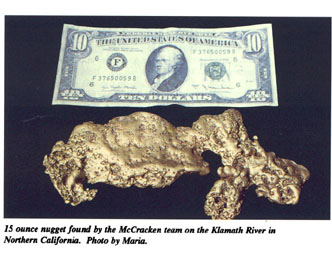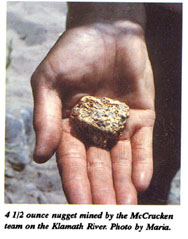By ROY F. Mayo
 Can you imagine finding a slab of gold so large you have to chop it with an ax to make it small enough to move? Or a chunk of quartz so filled with gold that a hammer blow shatters the quartz, but the gold has to be cut from the vein? How about a ton of gold in a small surface cut?
Can you imagine finding a slab of gold so large you have to chop it with an ax to make it small enough to move? Or a chunk of quartz so filled with gold that a hammer blow shatters the quartz, but the gold has to be cut from the vein? How about a ton of gold in a small surface cut?
In these days when some of us have to be satisfied with finding a few flakes of gold, it is hard to believe such finds were actually made. It is even harder to believe that these finds were made practically in our own backyards!
We hear of huge nugget finds in Australia, deep mines in South Africa, fantastic mines in South America and other exotic places. Most of us will never have the opportunity to visit these far away places. But maybe we can explore some of the places where fantastic finds have been made in our own area.
All of our mining areas have their own special stories. Gold rushes to many areas were started by the mere rumor of a fantastic find. Many of these rumors proved false, but resulted in some of the lost mine stories that are now a part of our folklore.
The early miners were primarily placer miners. Most were inexperienced; very few even knew what natural gold looked like! Placer gold was easy to recover and identify. As the miners gained experience, many began looking for the source of the placer gold.
It was found that the trace of gold could be followed upstream to the point where it stopped. Then by searching the hillsides above the stream, the lode source could sometimes be found. Some of these lodes were developed into valuable mines.
Each mining area has a distinctive type of gold. Gold, in its natural form, is never found in a pure state. Other metals are always alloyed with the gold. The purity of the gold is determined by the percentage of other metals in the alloy.
Each mining area also has distinctive sizes and shapes of gold particles. Some areas are noted for the size of the nuggets produced; other areas produce only microscopic particles of gold. The type of gold in the area determines the method of searching for it.
All placer gold originated in a lode vein. If large nuggets were found in the stream placers, they sometimes led to fabulous lodes. The early miners discovered many valuable lode mines and pockets by following the placer leads.
Southwest Oregon is noted for pocket mines. Most of these were located by following the placer leads to the source. As a vein of gold weathers and wears away over the centuries, gold will spill down the hill or mountainside, spreading in a V-shaped pattern as it migrates down to the nearest stream. Some pockets produced only a few ounces of gold. Others, such as the famous Gold Hill Pocket, produced up to a ton of gold.
Some miners specialized in pocket hunting. They developed an inverted V method of searching for pockets. When the placer lead stopped in the stream, they started digging test holes on the hillsides. As the rows of test holes progressed uphill, the inverted V pattern was established by the holes which produced gold. The pocket of gold was found at the point of the inverted V.
Some pocket hunters worked on the theory that pockets always occurred in groups of three. When the surface pocket was worked out and the vein pinched off, they kept digging and sometimes were able to strike a second and third pocket.
The first lode mine in Oregon State was a pocket mine. It was called the Hicks Lead. This small pocket produced $1,000 in two hours. It was later sold to a group of miners who built the first arrastra in Oregon State.
The fabulous Gold Hill Pocket was discovered in 1857 near the top of a small 2,000 foot-high mountain. This pocket was a fissure-vein four to five feet wide and fifteen feet deep. The outcropping rock was literally tied together with gold. It was almost impossible to tear it apart with a sledge hammer. At least $700,000 was recovered from a very small area. With gold valued at $20.67 per ounce at that time, this works out to over $14 million at today’s gold price. Gold Hill is a landmark along the 1-5 Freeway two miles from the city of Gold Hill.
The Steamboat Pocket was discovered in 1860 near the headwaters of the Applegate River. Over several year’s time, it produced over $350,000. Compared to these two, other Oregon pockets seem minor. However, each was a fabulous find in its own right. At the time of their discovery, many of these pockets were made in extremely isolated areas.
One of Oregon’s most famous pockets, the Briggs Pocket, may have been the re- discovery of a lost mine. During the Indian uprising in 1855, two men on their way to join the fighting found an outcropping of quartz. They each broke off a chunk, which was later sold for $100. They were never able to relocate their find. Almost a half century later, in 1904, an 18-year-old hunter, Roy Briggs, relocated the lost mine. This small pocket produced gold in slabs one inch thick and two to three feet long. A total of at least $50,000 was recovered from the vein 12 to 14 inches wide, 12 feet long and 7 feet deep. Reporters for the Rogue River Courier described the Briggs tent as having “gold in sacks, in cans, in bottles, in the mortar, in the gold pans, in tin cups and cooking utensils, everywhere”. This discovery was actually made in Thompson Creek near the Oregon-California border.
Several large nuggets have been found in Oregon’s placer mines. A 204-ounce whopper was found in 1859 on East Fork Althouse Creek. Buck Creek produced the famous 80.4 ounce Armstrong nugget. A 34-ounce nugget was found in Brimstone Gulch.
In the early mining days, and even extending well into this century, gold had no special specimen value. An outstanding nugget would be tossed into the melting pot along with the common gold. Most of our record-size nuggets have been lost as a result of this practice.
Miner John Dodge took a mighty swing at the shale bedrock at his mine near the Yuba River, and stuck his pick in the gigantic Downieville nugget, which may have been even larger than the Calaveras nugget. When the monstrous heart-shaped nugget was pried from its resting place, it was weighed on a make-shift scale. A plank was balanced, then the huge chunk of gold was placed on one end. Small rocks were then placed on the other end until it balanced, then the small rocks were weighed. The pile of small rocks weighed 227 pounds. Then the nugget was chopped into three pieces to make it small enough to carry. Each piece was later sold for approximately $17,000.
 Have all the big nuggets and slabs of gold been found? I don’t think so. Several very interesting discoveries have been made in recent years. A California deer hunter tripped over a rock. When he picked the rock up, he found he was holding a fist-sized gold nugget.
Have all the big nuggets and slabs of gold been found? I don’t think so. Several very interesting discoveries have been made in recent years. A California deer hunter tripped over a rock. When he picked the rock up, he found he was holding a fist-sized gold nugget.
A Colorado miner noticed a rock by the road as he drove to work each day. When he stopped for a closer look, he found a piece of float weighing several hundred pounds. It was loaded with visible gold and is now in a Colorado Museum.
Our chances of finding a large nugget or a massive slab of gold may actually be better today than ever before. New improved diving and dredging techniques now allow us to explore and work many areas of virgin ground. Underwater placers, never before accessible, can now be worked with ease. As just one example of many, the nuggets shown is this article were just-recently dredged out of the Klamath River by Dave McCracken on claims managed by The New 49’ers Prospecting Association.
The development of new and improved electronic prospecting instruments may now enable us to locate deeply hidden veins. These deeper penetrating instruments may be able to locate nuggets the earlier miners missed by inches in ancient river channels.
We now have many opportunities never before dreamed of. I am getting a serious case of gold fever just writing this. I’ll see you up in the hills. Good luck.
About the Author: Roy F. Mayo was born a few years before the great depression of the 1930’s. His early life was spent in Western Oklahoma and Texas. He served in the US Army during WWIl, and has lived in Washington state since 1955. Having been a small-scale gold miner for more than 40 years, he has searched for gold in most of the western mining states. Roy has stated that he found gold in many places, but his richest reward has been the pleasure of exploring many historic places with his family.
Roy started his writing career quite by accident in the early 1970’s. While searching an area in Idaho where a group of Chinese miners had been murdered, the local librarian encouraged him to write the story for reference material in the library. This later became his first book, GOLD AND STRYCHNINE. Now a world-renowned author, he has eight published books and is presently working on guide books showing gold locations in several of the Western states. These will be in the same format as his books, WASHINGTON STATE GOLD MINES and GOLD MINES OF SOUTHWEST OREGON.
- Here is where you can buy a sample of natural gold.
- Here is where you can buy a basic gold prospecting kit.
- More about gold
- More about the history of gold
- More about how to prospect for gold
- Schedule of upcoming events
- Books and videos by Dave McCracken.





